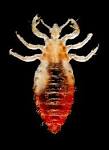Headlice advice
Being a primary school, we regularly get children and parents reporting that their children have headlice.
There are as many "cures" for this, it seems, as there are headlice! So we have chosen a lovely photo of one of these fellows to remind you of what they look like. They are not this big, of course, but the photo does encourage parents to get rid of them!

To help you with treatment, you can follow one of the following sites, all of which contain useful information:
- NHS Choices - Headlice
- Patient.co.uk - Headlice and Nits
- HealthScotland advice - Headlice Information for parents
Other advice from the HPA is given here:
Headlice:
Factsheet for Schools - Wired for Health
What are head lice (Pediculosis)?
- Head lice are parasitic insects called Pediculus humanus capitis. They only live on the heads of people.
- There are three forms of head lice:
- Nits are head lice eggs. The oval, yellowy white eggs are hard to see and may be confused with dandruff. They attach themselves to the hair shaft and take about a week to hatch. The eggs remain after hatching and many nits are empty egg cases.
- Nymphs hatch from the nits. The baby lice look like the adults, but are smaller. They take about 7 days to mature to adults and feed on blood to survive.
- Adults are about the size of a sesame seed. They have six legs and are tan to greyish-white. The legs have hook-like claws to hold onto the hair with. Adults can live up to 30 days and feed on blood.
- Head lice cannot jump, hop or swim.
Who catches head lice?
- Anyone can catch head lice, but preschool children, primary school children and their families are most at risk.
- Studies in the United States have shown that black African Americans rarely get head lice.
How do you catch head lice?
- Head lice are transmitted through direct, prolonged head-to-head contact with an infested person. This is especially common during play or sport at school and with close contacts at home.
- Transmission is possible through infected clothes, combs, brushes or towels, but extremely unlikely. The lifespan of a louse is very short once detached from the hair so fumigation is not necessary.
How infectious is head lice?
- The rate of transmission is low.
What is having head lice like?
- The head lice are most commonly found behind the ears and at the back of the neck. It is rare to find them on the body, eyelashes, or eyebrows.
- A person with head lice may feel a tickling or itching feeling of something moving in the hair. Most people only realise that they have head lice after the itch has developed which can take from one week to 2-3 months after initial infection.
- Itching may also occur due to an allergic reaction to the bites.
- Sores can develop due to scratching and can become infected.
How serious are head lice?
- Head lice are not a serious health problem.
- Head lice rarely cause anything more than an itchy scalp.
Can you prevent head lice?
- Head lice are a mild disease. Some schools used to have routine screening, followed by the exclusion of those affected. This was a waste of time. It was also ineffective in preventing spread.
- The best way to stop infection is for people to learn how to check their heads for lice.
- Good hair care only helps to control lice in as much as it will help to spot and treat lice early.
Should a child with head lice be kept off school?
- No! The DfEE/DoH guidelines for infection control in schools and nurseries state that there is no need for a child who has head lice to stay away from school.
- One reason for this is that if a child does have lice, he or she will have had them at school for several weeks before diagnosis.
- Letters notifying other parents of cases have not been found to curtail spread but often provoke itching and anxiety as a psychological response.
How can you treat someone with head lice?
- A diagnosis of head lice can only be made if a living, moving louse is found.
- Detection combing by parents/family members according to instructions is the best method of diagnosis.
- Chemical treatments are available, but must only be given after a doctor or experienced nurse has made a diagnosis.
- Close contacts of patients living in the same house are usually checked and treated if they have head lice.

